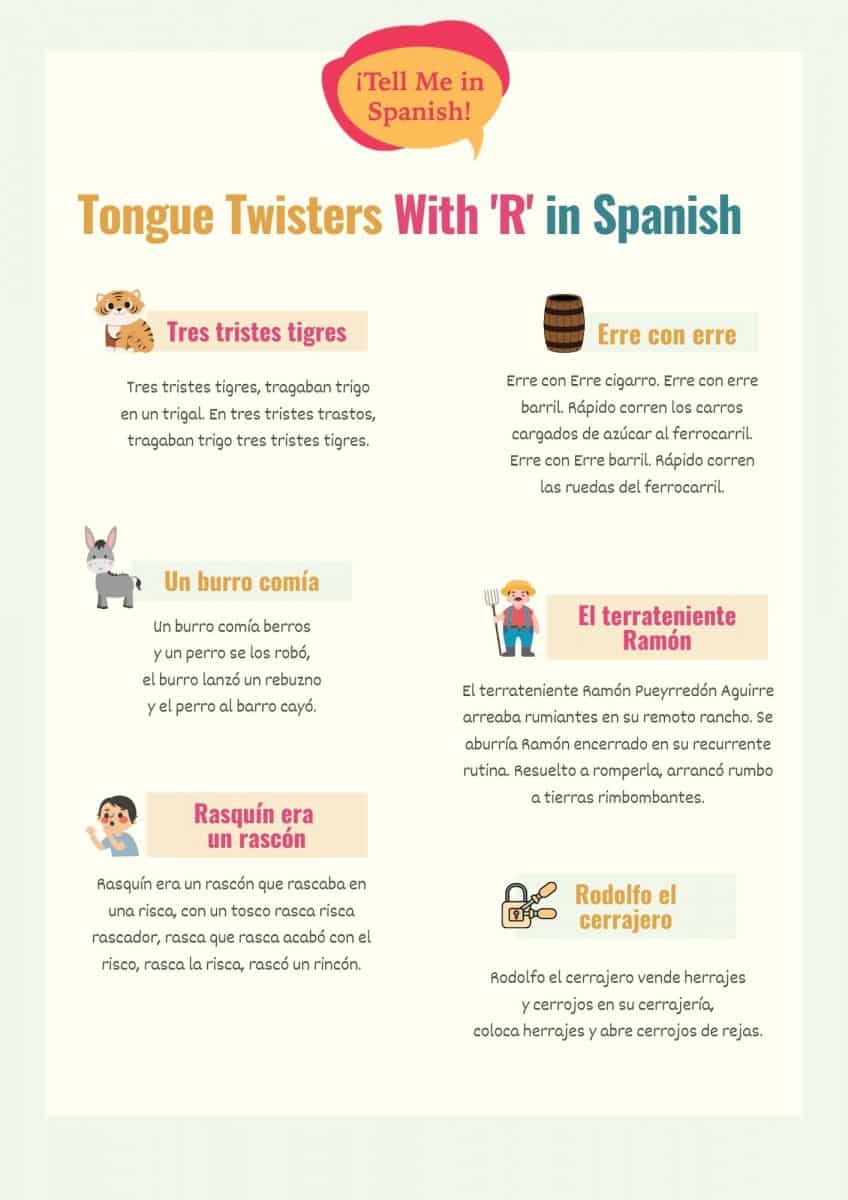When it comes to learning Spanish, many people overlook their pronunciation. After all, if they’re able to communicate, having a thick accent or mispronouncing certain words doesn’t seem like a big deal, right? However, if you’re serious about getting rid of your accent, Spanish tongue twisters are an easy and effective way to improve your pronunciation.
Having good pronunciation is fundamental for effective communication. Since Spanish tongue twisters provide exposure to challenging sounds, in this article, you’ll find the most popular tongue twisters that you can use to train your pronunciation skills. Here is what you’ll learn through this article:
- How to Use Spanish Tongue Twisters
- Easy Spanish Tongue Twisters
- Hard Tongue Twisters in Spanish
- Tongue Twisters in Spanish with ‘rr’
- Benefits of Spanish Tongue Twisters
In addition to providing you with the written tongue twisters, I’ve also included audio recordings so you can hear the sounds and the pronunciation you have to follow…Just don’t laugh if I make any mistakes!
Take Note: Just in case you were wondering, trabalenguas is the Spanish equivalent of “tongue twister”.

Tips to Use Spanish Tongue Twisters
When used correctly, tongue twisters in Spanish are an excellent tool to train your vocal organs to improve your pronunciation and articulation. If you’re unsure of what to do, here are some easy tips on how to use Spanish tongue twisters:
- Find a tongue twister that addresses a sound that you want to improve.
- Listen to a native speaker saying the tongue twisters.
- Identify the sounds and intonations.
- Repeat single words or sounds that are challenging for you.
- Say the tongue twister slowly and build up the speed.
- Repeat the same Spanish tongue twister a couple of times.
- Add more Spanish tongue twisters to the mix and practice several times a day.
Take Note: Tongue twisters in Spanish are formed with words that have similar sounds. Because of this, not all the words or sentences you’ll see will make sense. Since tongue twisters in Spanish are meant to help you with pronunciation, you shouldn’t pay attention to the vocabulary or grammatical structures they use.
Easy Tongue Twisters in Spanish
If this is the first time you’re trying trabalenguas, you may want to start with a set of easy and effective Spanish tongue twisters. In the list below, you’ll find some common tongue twisters that you can use to warm up. If you’re unsure how to pronounce certain words, listen to the audio.
1. Pepe pecas pica papas con un pico…
If you want to make things easier for yourself, you can repeat the sentence above repeatedly. However, the full version of this popular Spanish tongue twister goes like this:
Pepe pecas pica papas con un pico. Con un pico pica papas Pepe Pecas. Si Pepe Pecas pica papas con un pico, ¿dónde está el pico con que Pepe Pecas pica papas?
This simple tongue twister works with the ‘p’ and ‘c’ sounds. Even though these aren’t usually challenging sounds, repetition is an excellent exercise to train your organs of articulation.
2. Si Pancha plancha…
Si Pancha plancha con pocas planchas, ¿con cuántas planchas plancha Pancha?
‘Si Pancha plancha con…” is a short Spanish tongue twister that addresses the ‘pl’ sound, which tends to be complicated for some students. Since it’s built with a conditional sentence and question, this tongue twister is also good for practicing your Spanish intonation.
3. Cuando cuentes cuentos…
This is an example of a Spanish tongue twister that focuses on the repetition of the sound ‘cu’ in different words. Additionally, the words used in this tongue twister are actually common in Spanish conversations.
Cuando cuentes cuentos, cuenta cuántos cuentos cuentas,
porque si no cuentas cuántos cuentos cuentas
nunca sabrás cuántos cuentos cuentas tú.
4. Jamás juntes a jinetes…
People learning Spanish struggle to pronounce the letter ‘g’ and ‘j’. In fact, most beginners confuse the sounds of these letters. If you’re experiencing troubles with these sounds, the following Spanish tongue twister will help you address this issue.
Jamás juntes a jinetes con los jóvenes germánicos ni generes germicidas,
ni congeles gelatinas, ni ajusticies a Juristas en sus juntas Judiciales.
5. En este año el niño Nuñez engañó al ñoño…
There are just a few languages that use the sound ‘ñ’. Since this is likely to be a new sound for you, you may need to practice its pronunciation. The following tongue twister is built around the sound ‘ñ’, so it can help you improve your command of this sound.
En este año el niño Núñez engañó al ñoño Noreña con la piñata de antaño.
Cuando el ñañigo Coruña encañonando el rebaño, en la cañada, con saña,
lo enseñaba a cortar caña.
Hard Tongue Twisters in Spanish
Now that you’ve warmed up with easy tongue twisters, it’s time to make things more challenging. Below, you’ll find some of the most popular hard tongue twisters in Spanish. So, make sure you take your time to understand the sounds you have to produce.
1. Hay chicas chachareras que chacotean con chicos chazo…
Due to the constant repetition of the sound ‘ch’, this Spanish tongue twister can be complicated for many new learners. Given that many words in Spanish have this sound, you should take the time to practice its pronunciation.
Hay chicas chachareras que chacotean con chicos chazos. Y un chico mete al chillón de la chepa un chichón por chirrichote, y el chiste, y lo chocante, es que la chepa se le ha chafado
con la hinchazón del chirlo.
2. Yo tengo una gata ética…
In addition to helping you practice the letter ‘l’ with consonants and vowels, this tongue twister also focuses on training your voice to mark the Spanish accents on a word. Give it a try, and don’t forget to pay attention to the accents!
Yo tengo una gata ética pelética pelín plamplética, pelada peluda pelín plampluda, que tiene gatitos éticos peléticos pelín plampléticos, pelados peludos pelín plampludos. Si la gata no fuera ética pelética pelín plamplética pelada peluda pelín plampluda, los gatos no serían éticos peléticos pelín plampléticos pelados peludos pelín plampludos.
3. El volcán de Parangaricutirimícuaro…
Unlike others in this list, this Mexican tongue twister doesn’t make a lot of sense, but it has complicated words that can be difficult to master, which will help your Spanish articulation.
El volcán de parangaricutirimícuaro se quiere desparangaricutirimicuarizar y quien lo desmparangaricutirimicuarizare buen desparangaricutirimicuarizador será.
Tip: the key to this tongue twister is to master the sounds in the word Parangaricutirimícuaro.
4. Pablito clavó un clavito en la calva de un calvito…
Pablito clavó un clavito is one of the most famous tongue twisters in Spanish. Personally, I’ve always struggled with it. This Spanish tongue twister will help you practice the different sounds of the letter ‘l’ when combined with vowels or consonants.
Pablito clavó un clavito en la calva de un calvito, un clavito clavó Pablito en la calva de un calvito ¿Qué clavito clavó Pablito?
Tongue Twisters to Improve the ‘rr’ Sound
Producing the sounds ‘r’ and ‘rr’ is, without a doubt, the most challenging thing in Spanish pronunciation. The following tongue twisters can be extremely valuable if you want to work on these sounds.

1. Tres tristes tigres tragaban trigo en un trigal
Tres tristes tigres, tragaban trigo en un trigal.
En tres tristes trastos, tragaban trigo tres tristes tigres.
2. Erre con erre cigarro…
Erre con Erre cigarro. Erre con erre barril.
Rápido corren los carros cargados de azúcar el ferrocarril.
Erre con Erre barril. Rápido corren las ruedas del ferrocarril.
3. Un burro comía berros…
Un burro comía berros
y un perro se los robó,
el burro lanzó un rebuzno
y el perro al barro cayó.
4. El Terrateniente Ramón…
El terrateniente Ramón Pueyrredón Aguirre
arreaba rumiantes en su remoto rancho.
Se aburría Ramón encerrado en su recurrente rutina.
Resuelto a romperla, arrancó rumbo a tierras rimbombantes.
5. Rasquín era un rascón que rascaba…
Rasquín era un rascón que rascaba en una risca, con un tosco rasca risca rascador, rasca que rasca acabó con el risco, rasca la risca, rascó un rincón.
6. Rodolfo el cerrajero…
Rodolfo el cerrajero vende herrajes
y cerrojos en su cerrajería,
coloca herrajes y abre cerrojos de rejas.
What Are the Benefits of Tongue Twisters in Spanish?
Even though most people think tongue twisters are for kids, different researchers have studied the importance of tongue twisters for language learning. If you still have doubts, here are some of the benefits of saying tongue twisters in Spanish:
- Trains your organs of articulation: since they focus on challenging sounds, Spanish tongue twisters force you to learn new movements with your organs of articulation. As a result, you’ll learn to produce those Spanish sounds more accurately.
- Provides exposure to challenging sounds: as mentioned before, tongue twisters in Spanish are formed with similar sounds that can be complicated to pronounce. By saying tongue twisters, you’ll be able to identify and produce difficult sounds.
- Keeps you engaged: since they’re a fun activity with a clear goal, tongue twisters can help you stay motivated to improve your pronunciation. This motivation can increase if you find a friend or classmate who wants to practice with you.
- Reduces your accent: given that you get to practice the same sound repeatedly, tongue twisters in Spanish will help you improve your pronunciation and articulation. To make the most out of this activity, make sure you listen to a native speaker first so you don’t develop bad pronunciation habits.
- Improves your reading: if you haven’t memorized the tongue twister, you’ll be forced to read at high-speed. Even though they’re small reading samples, tongue twisters can help you improve your reading skills and get more comfortable with long and complicated words.





